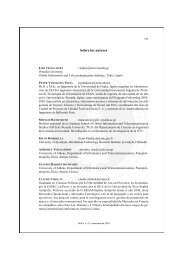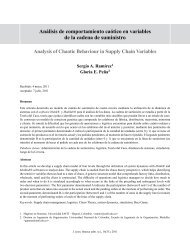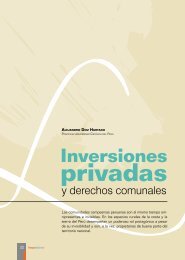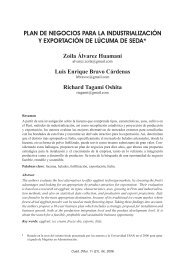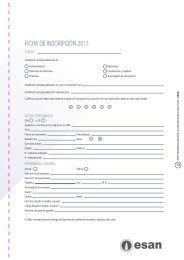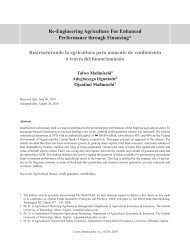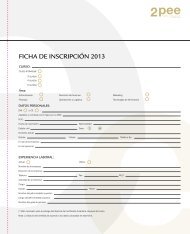34 Journal of Economics, Finance <strong>and</strong> Administrative ScienceDecember 20114. Trip planning/prior arrangements:Considering the complexity of the tourism products<strong>and</strong> various risks associated with international travel, itis natural for many tourists to take measures to reducesuch risks. The extent to which a tourist is concernedwith such risk reduction behaviors is a function againof his/her personal <strong>and</strong> psychological characteristics aswell as cultural orientations. In this context, Hofstede’s(1980) cultural dimension of uncertainty avoidanceis extremely relevant. <strong>Tourist</strong>s from cultures whichare low on uncertainty avoidance are likely to have ahigher threshold for risk <strong>and</strong> uncertainty <strong>and</strong> thus willengage in risk reducing behaviors to a lesser extent.Conversely tourists from cultures, which are high onuncertainty avoidance are likely to have a low thresholdfor risk <strong>and</strong> uncertainty <strong>and</strong> thus will engage in riskreducing behaviors to a greater extent.<strong>Tourist</strong>s undertake such risk reducing behaviorsboth in before-travel <strong>and</strong> during-travel stages. Thebefore-travel risk reducing behaviors include extensivetrip planning, use of travel agents <strong>and</strong> tour operators,making prior travel arrangements, pre-payment fortourism components etc. Two research studies dealingwith these issues are Money <strong>and</strong> Crotts (2003), <strong>and</strong>Crotts <strong>and</strong> Litvin (2003). Both of these studies useda subset of database compiled by the U. S. Departmentof Commerce’s Office of Travel <strong>and</strong> TourismIndustries (OTTI). Money <strong>and</strong> Crotts used data set forthe years 1996-1998 <strong>and</strong> their study included nativeGerman <strong>and</strong> Japanese discretionary travelers. Crotts<strong>and</strong> Litvin used data set for the year 2000, <strong>and</strong> theirstudy included outbound tourists from U. S. whoseplace of birth differed from their nation of citizenship.The participants were born in 74 countries, residedin 81 countries, <strong>and</strong> were citizens of 68 nations. Thefindings of both studies indicated that tourists fromhigh uncertainty avoidance cultures had taken risk<strong>and</strong> uncertainty reducing measures such as inclusionof pre-paid tours <strong>and</strong> pre-booked lodgings to a greaterextent than tourists from low uncertainty avoidancecultures.Studies of <strong>Tourist</strong> <strong>Behaviors</strong> During-TravelThis sub-section includes five tourist behavior domains,four of which capture the risk-reducing behaviors relatedto the during-travel stage. These four domains are tripduration/length of stay, number of destinations in theitinerary, travel party size/travel companions, <strong>and</strong> travelfrequency. The fifth tourist behavior domain included inthis subsection is behavior of tourists on group tours.1. Trip duration, number of destinations in the itinerary,travel party size, travel frequency:The two research studies related to the risk-reducingbehaviors in the before-travel stage discussed earlier(Money & Crotts, 2003; Crotts & Litvin, 2003), alsoexamined several risk-reducing behaviors related to theduring-travel stage. The findings of these two studiesindicated that tourists from the high uncertainty avoidancecultures had taken risk <strong>and</strong> uncertainty reducingmeasures related to the during-travel stage also to agreater extent compared to the tourists from the lowuncertainty avoidance cultures. Specifically, the findingsof these two studies indicated that tourists from highuncertainty avoidance cultures compared to touristsfrom low uncertainty avoidance cultures had shorterstays in USA, visited fewer destinations in the itinerary,<strong>and</strong> traveled with a larger party size.An alternate construct used to explain the culturaldifferences in business settings is “<strong>Cultural</strong> Distance”or the gap between the business cultures of the visitor<strong>and</strong> the host. Early research by Kogut <strong>and</strong> Singh(1988), using Hofstede’s four cultural dimensions,yielded inconsistent findings. Subsequently, Hofstede(1989) suggested that the use of uncertainty avoidancedimension to operationalize cultural distance will bemore appropriate because this particular dimensionis more disruptive than the others in the context ofinternational business.Crotts (2004) opertionalized “<strong>Cultural</strong> Distance”using national uncertainty avoidance scores <strong>and</strong> studiedthe overseas travel behavior of 302 outbound travelersfrom USA to 26 different countries. Only the U. S. bornJ. econ. finance adm. sci., 16(31), 2011
Vol. 16, Nº 31Manrai & Manrai: Hofstede’s <strong>Cultural</strong> <strong>Dimensions</strong> <strong>and</strong> <strong>Tourist</strong> <strong>Behaviors</strong> 35residents traveling abroad for the first time, <strong>and</strong> primarilytraveling for discretionary purposes (non-business),were included in the survey. This control of the samplewas done to eliminate confounding in the base scoreof participants on Uncertainty Avoidance dimension,which was used for determining the <strong>Cultural</strong> Distance.All the participants were assigned a base UncertaintyAvoidance score of 43 as per Hofstede’s (1980) study.The cultural distance was compared by subtracting thisbase score of 43 from Uncertainty Avoidance score ofthe host countries to which the participants were headed.Crotts (2004) predicted that the cultural distance willbe positively correlated with risk-reducing behaviorssuch as larger travel groups, less frequent travel, shortertrips, <strong>and</strong> lower number of destinations in the itinerary.Finding of his study supported these predictions. Whenthe cultural distance was low, Uncertainty AvoidanceIndex of the host country was closer to that of the U.S. A., the international tourists traveled alone, traveledmore often, took longer trips <strong>and</strong> visited a greaternumber of destinations.2. Behavior of tourists on group tours:The four research studies reported in this subsection(Pizam & Sussmann, 1995; Wong & Lau, 2001; Kim& McKercher, 2011; Meng, 2010) discuss the behaviorof tourists on group tours. The first three studies differfrom each other in three ways, namely, the methodology,the composition of the sample, <strong>and</strong> the basis ofcultural comparison. First, in terms of the methodology,Pizam <strong>and</strong> Sussmann (1995) used an indirect methodof assessment, which was based on perceptions of tourguides. Wong <strong>and</strong> Lau (2001) study directly assessedthe tourist behavior: the tourists completed a surveyquestionnaire. As for Kim <strong>and</strong> McKercher (2011), theycompared <strong>and</strong> contrasted the responses of the tourists<strong>and</strong> service providers relating to expectations of desirabletourist behaviors <strong>and</strong> the perceptions of actualtourist behaviors.In terms of the composition of the sample, the tourgroup in Pizam <strong>and</strong> Sussmann (1995) study comprisedof four different nationalities: citizens from the U. S. A.,France, Italy <strong>and</strong> Japan. The tour groups in the studies ofWong <strong>and</strong> Lau (2001) <strong>and</strong> Kim <strong>and</strong> McKercher (2011)comprised of only Hong Kong Chinese tourists <strong>and</strong> onlyKorean tourists respectively. The third difference in thethree studies related to the basis of cultural comparison.In Pizam <strong>and</strong> Sussmann (1995), the behavior of thefour nationalities based subgroups of tourists werecompared with each other. In Wong <strong>and</strong> Lau (2001),the behavior of the Hong Kong Chinese tourists wasexamined in relation to the Chinese <strong>Cultural</strong> Values; inthe Kim <strong>and</strong> McKercher (2011) study, the focus was inunderst<strong>and</strong>ing the differences in the expectations of thedesirable tourist behaviors vis-à-vis perceptions of theactual tourist behaviors. The fourth study reported inthis sub-section on behavior of tourists on group toursis a conceptual article, which develops four researchpropositions for further empirical testing.The respondents in Pizam <strong>and</strong> Sussmann (1995)study were 123 tour guides in London, U. K., whoregularly guided tours within the city. A total of 252questionnaires were completed by the tour guidesassessing the behavior of U. S., French, Italian, <strong>and</strong>Japanese tourists during their tour. Thus, on an average,the tour guides completed two different questionnairesfor tourists of two different nationalities. These 252questionnaires included 97 U. S. tourists, 57 Frenchtourists, 43 Italian tourists, <strong>and</strong> 55 Japanese tourists.The questionnaires included twenty typical tourists’behaviors <strong>and</strong> the respondent tour guides indicatedtheir assessment of the tourist behaviors by circling anumber from 1 to 5 on each of these 20 arched semanticdifferential scales.The data were analyzed using factor analysis <strong>and</strong>yielded five factors. These five factors were labeledas follows: “Social Interaction Factor” (SIF), “ActivityPreference Factor” (APF), “Commercial TransactionFactor” (CTF), “Bargaining Factor” (BPF) <strong>and</strong>“Knowledge of Destination Factor” (KDF). The BPFalso included planning behavior. The ANOVA analysiswas performed for all 20 items included in these fourfactors.The SIF included six items dealing with interaction,socialization, <strong>and</strong> congregation, focus on peopleJ. econ. finance adm. sci., 16(31), 2011
- Page 1 and 2: Hofstede’s Cultural Dimensions an
- Page 3 and 4: Vol. 16, Nº 31Manrai & Manrai: Hof
- Page 5 and 6: Vol. 16, Nº 31Manrai & Manrai: Hof
- Page 7 and 8: Vol. 16, Nº 31Manrai & Manrai: Hof
- Page 9 and 10: Vol. 16, Nº 31Manrai & Manrai: Hof
- Page 11: Vol. 16, Nº 31Manrai & Manrai: Hof
- Page 15 and 16: Vol. 16, Nº 31Manrai & Manrai: Hof
- Page 17 and 18: Vol. 16, Nº 31Manrai & Manrai: Hof
- Page 19 and 20: Vol. 16, Nº 31Manrai & Manrai: Hof
- Page 21 and 22: Vol. 16, Nº 31Manrai & Manrai: Hof
- Page 23 and 24: Vol. 16, Nº 31Manrai & Manrai: Hof
- Page 25 and 26: Vol. 16, Nº 31Manrai & Manrai: Hof



